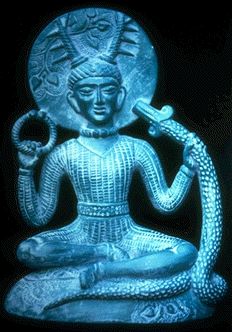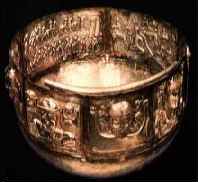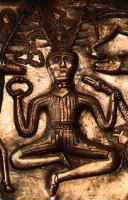CERNUNNOS

Cernunnos (sometimes spelled Kernunnos)
is one of the many names of the European Great Horned God. Whatever his
original Celtic name might have been has been lost in history. Cornu in
modern French means "horned, because modern French has grown from the
Latin language imposed upon them by the Romans. The Latin for horn is also
cornu. The Romans had a habit of changing local names to fit the Roman pattern:
most Roman names end in us. So Cernunnos is a Roman name meaning Horned
One. It was probably the new Romanised name given by the Gauls to all their
very old horned gods, in which case its use may have been widespread through
out Gaul after it became a Roman province.
He is portrayed on many Celtic artworks
and artifacts from as far back as they can be recovered, the most well-known
being the famous Gundestrup Cauldron (see below).
The images of him are unusually consistent. His main attribute are his horns,
those of a stag. He is usually portrayed as a mature man with long hair and
a beard. He wears a torc: this was an ornate neck-ring worn by the Celts to
denote nobility. He often carries other torcs in his hands or hanging from his
horns. As the Horned God he is depicted with the antler of a stag or horns of
a ram, and was probably the most widely worshiped God-form in European Paganism.
Sometimes he is drawn with a sack of coins which he is pouring onto the bare
earth, or with a club.
He was the randy goat
representing the fertility rites of Beltaine, and the master of
the hunt who came into his full power in the late summer and early
fall. He was the primal fertility God,consort to the first Great
Mother, and the male creative principle. He is also honored as
a death deity, and the hunt is sometimes viewed as a metaphor
for rounding up the souls of the living to take to the Otherworld.
He has also been cast as the role of guardian of the Otherworld
gates, and as a God of the woodlands, animals, revelry, and male
fertility.
His stories are sketchy and come largely
from oral sources. Herne is his British name. His Gaulish name was Dispater.
He is equated with the Greek God Pan whose name means "all." Both
Cernunnos and Pan became the prototype foe the Christian anti-God, Satan. This
was not a judgment on the attributes of these deities, but rather a device for
frightening the European populace away from the old religion.
The Song of Amergin
I am a stag of seven tines,
I am a wide flood on a plain,
I am a wind on the deep waters,
I am a shining tear of the sun,
I am a hawk on a cliff,
I am fair among flowers,
I am a god who sets the head afire with smoke.
I am a battle waging spear,
I am a salmon in the pool,
I am a hill of poetry,
I am a ruthless boar,
I am a threatening noise of the sea,
I am a wave of the sea,
Who but I knows the secrets of the unhewn dolmen ?
Origin obscure but certainly
Celtic
In Magick and Ritual:
Hunt, woodland, fertility, magick, sacrifice, and animals.
Correspondences: The stag, pan pipes,
oak leaves, rams horns, antlers.
The
Gundestrup Cauldron
The most detailed, clear and famous of all
images of Cernunnos comes from a unique and marvellous piece of Celtic work:
The Gundestrup Cauldron.
Cauldrons had magical significance for the
Celts, and this is the most ornate ever found. It was beaten out of 10 kg of
silver, probably in the second century BC, constructed from 13 heavily decorated
rectangular panels and a plain bowl containing a 14th circular one (possibly
a late addition). The entire assembly is 70 cm in diameter.
Sometime around the birth of Christ it was
taken to pieces and apparently just left on the ground in a bog near what is
now the hamlet of Gundestrup in Northern Jutland, where it gradually became
overgrown and covered with peat. It remained there until its discovery by peat
cutters in 1891.
The eight external panels (of which one is
missing) each feature what appears to be the single face of a different god
or goddess, surrounded by much smaller humanoids or beasts. The five interior
panels each depict many characters, men, women, gods and beasts, in what may
be a story.
 ;
;

One of these panels depicts Cernunnos.
He is seated cross-legged. He has antlers with
seven tines (or points per horn), and is, unusually, depicted clean-shaven.
He wears a torque and carries a second one in his right hand. He wears a tunic
and bracae (Celtic trousers) which cover him from the wrist to above the knee,
and a patterned belt. He wears sandals on his feet. His hair appears to be brushed
straight back.
In his left hand he holds the ram-horned serpent.
This serpent also appears on another two of the five interior panels.
Surrounding him are many beasts. The nearest,
on the left, almost touching horns with him, is a stag, itself of seven tines,
indicating his special affinity with this beast. Close to him on the right is
a dog. There are also two horned animals that may be ibexes, three long-tailed
animals that could be lions, and a boy on a fish. The space between the beasts
is decorated with a simple pattern of vegetation.
The five internal panels are complex, and feature
many characters who may be gods, goddesses or heroes. All of these characters
seem to appear also on one of the eight external panels, with the exception
of Cernunnos, who clearly does not. Did his image appear on the lost eighth
external panel ?
Partily based on http://www.lugodoc.demon.co.uk/cernunos.htm
The Section on the The Gundestrup Cauldron
is http://www.lugodoc.demon.co.uk/cernunos.htm

 ;
;
